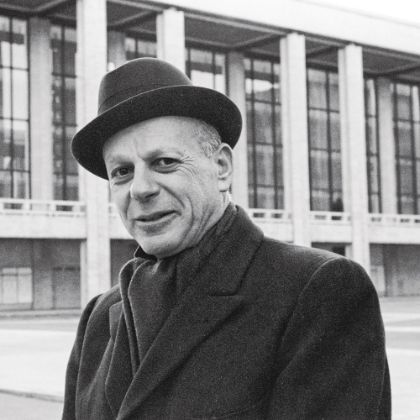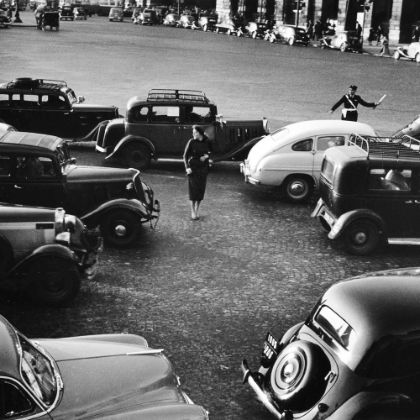PROMPTED BY A RECENT DOCUMENTARY, A FORMER BOY SINGER REMINISCES.
By Jens F. Laurson
a scene in günter atteln and Paul Smaczny’s film Die Thomaner: A Year in the Life of the St. Thomas Boys Choir Leipzig (DVD, Accentus) follows a cohort of nine-year-olds as they and their parents nervously climb the steps to Hillerstrasse 8 in Leipzig, Germany. This is the youngest crop of boys whose test-singing today will determine whether they will become Thomaner choristers. Soon they will present their (sometimes awfully raw) vocal material to Thomaskantor Georg Christoph Biller and his staff, who will listen and decide which kids can be incorporated into the choir’s eight-hundred-year-old tradition.
That tradition — steadied by faith — has provided a bulwark against starvation in the past and against totalitarian usurpation from both the right and the left in more recent history. That tradition’s most famous cantor, Johann Sebastian Bach, is only a blip on its very long timeline. And that tradition, according to Biller, now provides a sanctuary of sorts from the more shallow aspects of commercialism.
It doesn’t take very long for the images to start exerting a certain pull on me. I was eight when I made a similar trip, journeying with my piano teacher and my mother from my home in Munich to Regensburg. There I sang Matthias Claudius’s Abendlied and a few other bits in front of Georg Ratzinger, then director of the Domspatzen, the Regensburg cathedral choir. Ratzinger, the ex-pope’s elder brother and also a priest, has a wider, slightly less intimidating face than Benedict XVI — which might have helped calm my nerves. I remember a few mildly encouraging comments and knew by the time we left that I had been accepted: “The fourteenth non-Catholic in the choir’s history,” I remember with an accuracy that suggests it might not actually be true. But it sounds good.
There are obvious parallels between the two institutions. The Regensburg Cathedral Choir, with its thousand-year history, is in many ways the Catholic counterpart of the Leipzig choir, which has been proudly Protestant since 1539. Both choruses house their singers in boarding schools (in Regensburg, since the 1920s; in Leipzig, always). The Leipzig boys call their boarding school Kasten, or “The Box”; we called ours Kaff, roughly translatable as “Hick(s)ville.” Both institutions continue to involve their young performers after their voices break, reaping the benefits when the singers, already superbly trained, are reintegrated into the choir as tenors and basses. When I went to school in Regensburg in the eighties, we were additionally separated from Leipzig by the East–West German border. I don’t know how they saw it, but for us, the Thomaner were the only competition, however imagined that rivalry may have been. Even as little kids we were keenly aware of the tradition of their choir and the high standards to which they were held.
Die Thomaner shows that each of these students has responsibilities. For the older boys, that includes ushering newcomers through the unfamiliar, sometimes arcane procedures of boarding-school life. The eldest make sure that every chorister is spotlessly dressed before they go on stage or into the Thomas Church to perform their weekly Bach cantata. This hierarchy is good for the little ones, who have an intermediate contact to turn to before reaching out to the far-away authority of the adults. It might be even better for the upperclassmen, who grow into taking responsibility for their younger colleagues. They might even take pride in their assigned boys’ achievements, no matter what their stripe: vulnerable or strong, sunny or uppity, plain or shrill, hyperactive or reticent.
In my time in Regensburg, the prefects (Präfekten) were adult housemasters, most of them impossibly old (which then probably meant between twenty-five and fifty) and light-years removed from being realistic sources of comfort or confidants for one’s troubles.
Although I tear up at every viewing, the documentary isn’t particularly sentimental, except for a closing scene where the eldest choristers graduate and share teary goodbyes with their charges, who will, in turn, move on to offer guidance to the next generation of Thomaner boys. Instead, the film scores on moments of candor and honesty. Boys struggle with homesickness; boys admit they’re not always ready to meet the challenges of guiding younger kids or that they’re overwhelmed. Cantors and prefects speak openly about the difficult sides of life in boarding school, how it isn’t just communal fun and football games and trips to faraway places. “A certain robustness is necessary,” acknowledges Biller. “All-too-sensitive souls won’t last.”
Associated with the choir is the St. Thomas School, the oldest public school in Germany, and one of the most successful. Every Thomaner has always gone to the St. Thomas School, but not every one of the school’s seven hundred pupils — girls among them, since 1949 — is also one of the ninety-three choristers. That can create tensions: as much as teachers and students claim to eschew the word “elite,” there’s a smidgen of that lodged in every Thomaner’s mind. As the girlfriend of one of the elder pupils suggests with instinctive insight, when the others refer to the Thomaners as pansies or the like, it’s largely due to jealousy of all the things these kids can do and have already done: play Max Reger toccatas on the organ, sing in public concerts locally and worldwide, be role models (with varying degrees of success), lead the daily chorale before lunch and group rehearsals on Mondays, and trounce the Dresden Kreuzchor’s football team.
The film was made in 2011–12, just as the Kasten was about to be closed for substantial remodeling and the boys moved into temporary quarters nearby. It’s a nod to the times that six kids to a dorm room — and one large bathroom per floor — isn’t an attractive proposition anymore; not to the kids, and especially not to their parents. The new quarters will have two boys per room, each room leading to a common-area study and bathroom, but retain the tradition of mixing boys of various ages.
Either setup would be considered luxurious by the standards of 1980s Regensburg (which, of course, has also moved into the twenty-first century). Our fifth- and sixth-graders were segregated, and each tiny, one-hundred-sixty-square-foot room was shared by eight boys. Homework was done in large study halls; leaving the premises required written permission. There was no privacy and only a few places of refuge.
One such place was the nursery, where a gracious nun treated all kinds of lesser illnesses and ailments. She undoubtedly saw many cases of factitious disorder: boys faking vague feelings of sickness. But just as instinctively she must have known that what those patients really needed was not a Band-Aid or a pill, but a moment of calm and recollection, a cup of peppermint tea and an understanding ear. I faked plenty of physical discomforts to find my way to her.
‘A certain robustness is necessary...All too sensitive souls won’t last.’
A refuge I missed out on was Johann Sebastian Bach. It’s hard to tell if I reacted as viscerally to Bach then as I do now, but I certainly liked him, and knew his music from the tapes my father had meticulously made for me by recording radio broadcasts. But in a Catholic institution like Regensburg, Bach isn’t high on the list of priorities, and in three years I never sang any of his music. In Leipzig, on the other hand, Bach is the choir’s daily bread, the music that determines its sound. A B minor Mass on tour in Buenos Aires’s Teatro Colón or in São Paulo is a season’s — even lifetime’s — highlight. And at home every Sunday, Bach is heard in the Thomaskirche. I watch and listen with deep envy as the Thomaners perform the St. John Passion or speak of the inexplicable joy they get from the music. Even Biller suggests that while you can’t ever know God, you can sense him in Bach. Instead of Bach, I have anecdotes.
I have an anecdote about the huge, homemade stuffed toy snake I got from an aunt at my baptism, for example, which proved so devastating in secret nightly pillow fights that it earned itself the name — lamentably politically incorrect, even for a nine-year old — Hiroshīma. It is still alive and well, as is Jokko. Jokko was handed to me, wrapped and to be opened on my birthday, as I left for Regensburg after another stressful, biweekly one-day weekend at home. Not keen to return, I didn’t feel good leaving Munich, and I felt even worse after the train spat me out in Regensburg. Eventually my body followed suit, and physical sickness mixed with unhappiness. In an attempt at consolation, I got permission to open my package early, and out jumped a magnificent little plush monkey. Jokko turned out to be so terrifically moisture-absorbent, it became his primary duty to dry all my tears. By the time I left boarding school prematurely, Jokko’s sodium content was perilously high.
That I am particularly moved by this documentary has much to do with my own experiences, but also to do with the film’s production values. Every aspect exudes thoughtfulness, from the excellent, smartly applied choice of music (whenever the Thomaners are not providing their own soundtrack) and the editing to the carefully constructed, naturally dramatic arc. The result is a subtle, touching masterpiece about young life in symbiosis with old music.

related...
-

Master Builder
His compatriots made institutions of their music. William Schuman made institutions.
Read More
By Russell Platt -

Respighi: Beyond Rome
Respighi’s set of variations is cast away for his more
Read More
‘Roman’ repertoire.
By David Hurwitz -

L’amico Fritz
Mascagni delivers beautiful music, libretto be damned.
Read More
By Robert Levine